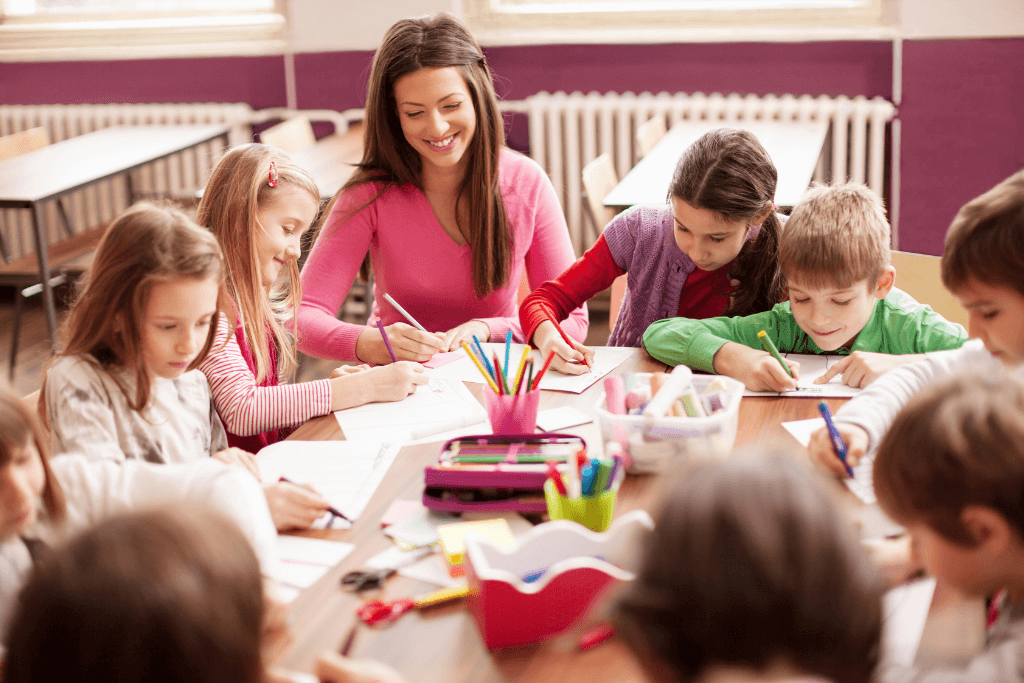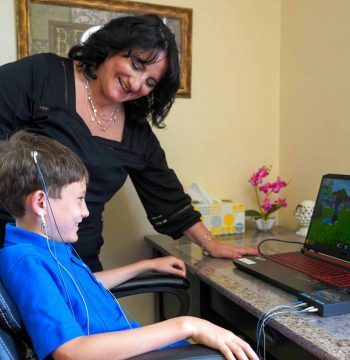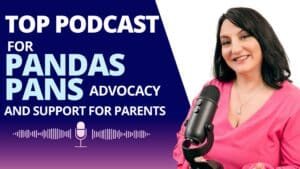When a parent of a dysregulated kid comes to me, they not only express their worry about big overactions at home but how it affects the child socially. Lucas was a middle schooler who struggled with emotional and behavioral regulation his whole life.
He was already kicked out of three schools by the time I met him at age 12. He didn't have one friend and in fact, a school report noted that he was a “social pariah.” Everything changed for Lucas when we calmed his brain and both his parents and the school focused on teaching emotional regulation skills.
I think most parents and teachers understand that social skills and emotional regulation are essential for a child's development but the challenge becomes how do we teach them? Even though we like to think that kids will just absorb social skills from other kids, it's not enough for a child to simply like being around others. Children who can't regulate their brains and bodies often experience emotional upset and may have difficulty forming connections with their peers.
Their tendencies to be easily upset, inflexible, rigid in play, impulsive and other behaviors that can be hard for others to understand get in the way of their ability to communicate, interact, and form meaningful relationships through reciprocal communication.
In this social world, social skills are needed to navigate every facet of life. Importantly, social interaction has a positive impact on a child's emotional regulation and overall mental health. Research has shown that social competence is related to self-regulation, and interventions targeting social skills can improve a child's self-regulation and emotional control (Zhou et al., 2012).
With patience, consistency and explicit instruction, these skills can be learned. Helping children develop social and emotional functioning is a multifaceted process that requires intentional effort and support both at home and in school but can be achieved.
What is Social-Emotional Learning?
Social-emotional learning (SEL) is the process of developing the knowledge, attitudes, and skills necessary to understand and manage emotions, set and achieve positive goals, feel and show empathy for others, establish and maintain positive relationships, and make responsible decisions.
SEL is a critical component of child development and is essential for success in school, work, and life. With the rise of neurodevelopmental disorders such autism, NVLD and ADHD, school systems are committed to social-emotional learning programs. The emphasis of these programs are teacher education about how to foster self-regulation behaviors and social skills.
What is the Link Between Social Emotional Learning Skills and Adult Outcomes?
Research has shown that children who develop strong social-emotional regulation skills are more likely to have better academic performance, improved mental health, and higher rates of employment and life satisfaction in adulthood. In contrast, children who struggle with social-emotional regulation may experience more behavioral problems, academic difficulties, and social isolation (Matchett et al., 2020).
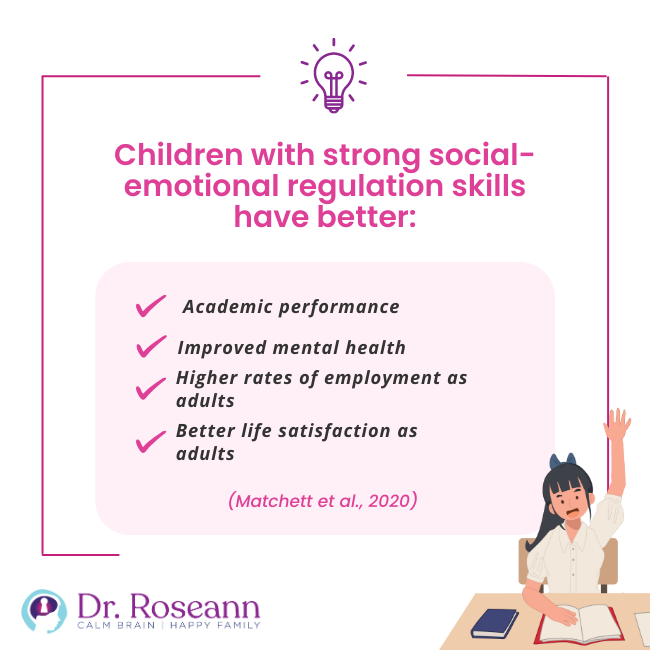
Many Failure to Launch young adults have a long history of social skill deficits. Therefore, it is important for parents and educators to focus on teaching children social-emotional regulation skills to set them up for success in the future.
Lucas is a perfect example of how right interventions pay off. As dysregulated as his behaviors were, when we calmed his brain with neurofeedback and PEMF and then taught his mom and dad just how to teach self-regulation and social skills, he was able to have an amazing highschool and college experience. He is now an adult and is even married!
What Does it Mean to Self Regulate With Social-Emotional Learning?
Self-regulation is the ability to manage one's emotions, thoughts, and behavior in a way that is appropriate for the situation. Self-regulation involves several skills, including emotional regulation, behavioral regulation, self-awareness, flexible thinking, executive functioning, understanding implicit social rules, and social competence.
The ability to self regulate can be impacted by clinical issues such as anxiety, OCD, depression, PANS/PANDAS, autism, ADHD, etc. These children need extra reinforcement to shape the behavior. Whether or not it is social skill developmental lag or autism, following evidence-based methods will help a child gain skills.
What Skills Do Children Need for Social Emotional Regulation?
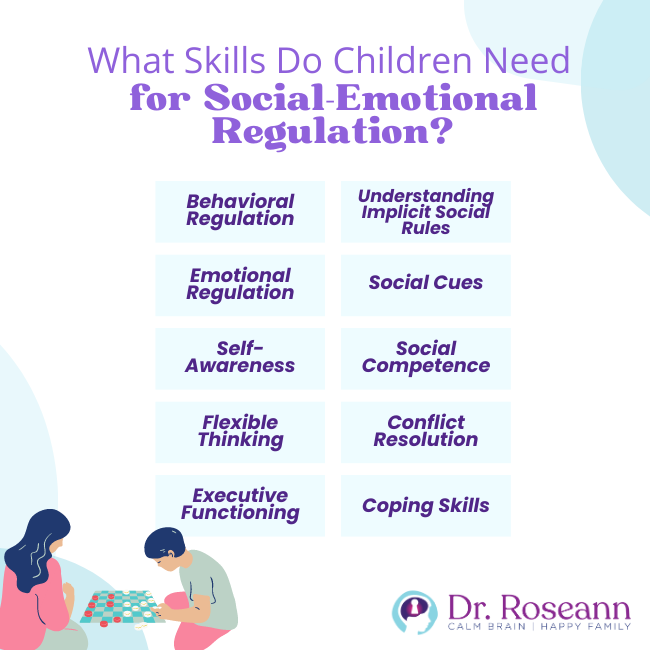
We often see our children struggle with regulating their emotions and behaviors but when they are overly emotional, it can be distressing for parent and child. We may witness them having a meltdown over a small issue, acting impulsively or struggling to control their anger. These behaviors can be frustrating and confusing, leaving parents wondering what they can do to help their child.
One of the key ways to support children in developing emotional and behavioral regulation is to understand the specific skills they need to learn.
Behavioral Regulation
Children need to be able to regulate their behavior to follow rules, routines, and expectations in different settings. Dysregulated children struggle with controlling impulses and that makes social emotional learning hard.
Emotional Regulation
Children need to be able to identify and regulate their emotions, respond appropriately to different emotions, and manage stress and anxiety. Without these skills, emotional regulation will continue to be a struggle.
Self-Awareness
Children need to be able to recognize and understand their own emotions, strengths, and challenges.
Flexible Thinking
Children need to be able to adapt to new situations, think creatively, and problem-solve. That means having flexible thinking.
Executive Functioning
Children need to be able to plan, organize, and manage their time and resources. The job manager of the brain is responsible for executive functions and those skills can be explicitly taught even if you have clinical issues such as ADHD or autism.
Understanding Implicit Social Rules
Children need to be able to understand and follow social rules that are not explicitly stated.
Social Cues
Children who have good social skills are better able to interpret social cues, such as facial expressions and body language, and regulate their emotions accordingly.
Social Competence
Children need to be able to establish and maintain positive relationships, communicate effectively, and cooperate with others.
Conflict Resolution
Conflict resolution skills can help children manage their emotions during conflict and prevent dysregulation. Teaching these skills can help them develop emotional regulation and social competence.
Coping Skills
Having a healthy set of coping skills to manage whatever stressors come your way is essential in all areas of life but especially important in managing social interactions.
How are Social Emotional Learning and Regulation Skills Taught?
Social-emotional regulation skills can be taught in a variety of settings, including at home and at school. Parents and educators can use different strategies to help children develop these skills, and with consistency, these skills can be learned.
My work is all about calming the brain and the first step in executive functioning is behavioral disinhibition, which means putting the breaks on. In order to do that, one has to calm the brain first. That is exactly what Lucas did and that is why he was able to self-regulate his social-emotional skills for the first time in his life.
Social-Emotional Regulation Skills
In order for children to develop strong social-emotional regulation skills, it takes more than just telling them what to do. It requires active modeling, teaching, reinforcing, and practicing. By taking a proactive approach to social-emotional regulation, parents and teachers can help children build a solid foundation for success in relationships, academics, and life.
Modeling
Parents and teachers can model positive social-emotional regulation behaviors by expressing emotions in a healthy way, managing their own stress, and problem-solving.
Teaching
Teach children social-emotional regulation skills explicitly, such as using feeling words to describe emotions or taking deep breaths to calm down.
Reinforcing
Reinforce positive social-emotional regulation behaviors by providing positive feedback and rewards.
Practicing
Create opportunities for children to practice social-emotional regulation skills in real-life situations, such as role-playing social
Social-Emotional Regulation Skills at Home: Parent Strategies
Parents play an essential role in their child's social-emotional development. It is crucial to create a home environment that is supportive, nurturing, and empathetic to help children develop healthy emotional regulation skills.
Even though parents may feel at a loss in how to support their dysregulated child in learning social skills, they can use several strategies to teach their children social-emotional regulation skills. There is no need to jump in and medicate your child because these are skills that can be taught. They require patience and consistency in order for your child to learn.
Here are some strategies that parents can use to teach social-emotional regulation skills to their children:
Modeling Emotion Regulation
Children learn by watching and copying their parents' behavior. When parents model positive coping strategies, children are more likely to adopt and utilize these skills. Using tools such as magnesium can help you and your child.
Create Safe Spaces for Expressing Emotions
Children should feel comfortable expressing their emotions at home but may lack the tools to do that. That leads to dysregulated behaviors. Those behaviors can show up as under stimulated or overstimulated actions due to differences in how their brain reacts to stress.
For example, an anxious child could exhibit angry behavior or avoidant behaviors. These behaviors reflect what areas of the brain are over working or under working. While how their brain processes emotions in the limbic system determines if one reacts or not, other systems related to inhibitory control also play an important role.
Parents can help create a safe space for children to express their feelings by actively listening, showing empathy, and validating their child's emotions.
Encourage Problem-Solving
Parents can teach their children how to identify problems, brainstorm possible solutions, and evaluate the pros and cons of each solution.
Role-Playing
Encourage children to act out social scenarios, problem-solve and practice conflict resolution skills.
Practice Mindfulness
Mindfulness practices such as deep breathing, meditation, and yoga can help children learn how to regulate their emotions and improve executive functioning. Parents can incorporate mindfulness practices into their daily routines by encouraging their children to take deep breaths when feeling overwhelmed or practicing yoga as a family.
Play Emotional Regulation Games
Playful emotional regulation activities that you can do at home are not only fun but they also provide meaningful opportunities for practice.
Embrace Neurodiveristy
Teach your child about their brain. When neurodivergent children understand their strengths and weaknesses, they can know themselves better. That means they don't have to feel ashamed and instead, love their brain.
Social-Emotional Learning and Regulation Skills at School: Teacher Strategies
Teachers also play a critical role in teaching social-emotional regulation skills to children because this is where most socialization occurs. When a child lacks social skills, they need as much support as possible in real life situations.
Here are some strategies that teachers can use to promote social-emotional regulation in the classroom:
- Teachers should create a safe and supportive classroom environment that is conducive to learning. This includes establishing clear expectations for behavior and providing positive feedback when students exhibit positive social-emotional regulation skills.
- Teachers should also teach social-emotional regulation skills directly to their students. This can be done through activities such as role-playing, storytelling, and problem-solving exercises.
- Visual aids such as posters, charts, and diagrams can be helpful in teaching social-emotional regulation skills. These aids can be used to help students understand and remember important concepts such as emotions, coping strategies, and problem-solving techniques.
- Provide opportunities for social-emotional learning through play.
- Encouraging parent involvement in their child's social-emotional development is something most teachers are doing. This can be done through regular communication, parent-teacher conferences, and providing resources for parents to use at home.
- Setting clear expectations and rules for behavior in the classroom is important for dysregulated kids. They can involve students in creating these rules to increase their buy-in and sense of ownership. Clear expectations and rules help students understand what is expected of them and provide a framework for positive behavior.
- Teachers can create a classroom culture that is positive, supportive, and safe. They can encourage positive interactions between students, praise students for positive behavior, and address negative behavior in a constructive way.
- Positive reinforcement to encourage and shape positive, prosocial behavior is essential. They can praise students for following rules, exhibiting self-regulation skills, and showing empathy towards others. It increases the likelihood that students will repeat these positive behaviors in the future.
- Teachers can provide explicit instruction in social-emotional regulation. It can include teaching students about emotions, teaching self-regulation strategies, and providing opportunities for practice and feedback.
- The explicit modeling of positive social-emotional behavior by adults can help students. It means regulating their own emotions, showing empathy towards others, and resolving conflicts in a constructive way.
- Teachers can use restorative practices to address negative behavior in the classroom. Restorative practices focus on repairing harm, restoring relationships, and building community. It helps students understand the impact of their behavior on others and develop empathy and problem-solving skills.
- Provide increased opportunities for learning for our neurodivergent students with ADHD, autism, anxiety, learning disabilities, etc.
Next Steps To Social-Emotional Learning and Regulation for Your Child
Social-emotional regulation skills are essential for children's overall well-being and success in life. These skills are learned through a combination of modeling, direct instruction, and practice. Parents and teachers can work together to teach children the skills they need to regulate their emotions, problem-solve, and interact positively with others.
By providing children with the tools they need to develop social-emotional regulation skills, parents and teachers can help ensure that they are well-equipped to handle the challenges of life and succeed in the future.
If you are looking to help your child go from a constant state of dysregulated behaviors and emotions, then you are ready for our BrainBehaviorReset™ Program, which is our premier one-to-one program designed to calm the brain and teach new skills.
Our six month program has the best of what science shows to calm the brain and behavior with just the right amount of parental guidance. If you want the best solution for your child and family then take our solution matcher today.
Parent Action Steps
☑ Model positive social-emotional regulation behaviors for your child by expressing emotions in a healthy way, managing your own stress, and problem-solving.
☑ Teach your child social-emotional regulation skills explicitly, such as using feeling words to describe emotions or taking deep breaths to calm down.
☑ Reinforce positive social-emotional regulation behaviors by providing positive feedback and rewards.
☑ Create opportunities for your child to practice social-emotional regulation skills in real-life situations, such as role-playing social interactions or problem-solving scenarios.
☑ Take our Solution Matcher to get science-backed solutions to help your child today.
Citations:
Bailey, R., & Murray, N. (2017). Understanding social emotional learning in schools. London: Sage Publications.
Brackett, M. A., Reyes, M. R., Rivers, S. E., Elbertson, N. A., & Salovey, P. (2012). Classroom emotional climate, student engagement, and academic achievement. Journal of Educational Psychology, 104(3), 700–712. https://doi.org/10.1037/a0027268
Durlak, J. A., Weissberg, R. P., Dymnicki, A. B., Taylor, R. D., & Schellinger, K. B. (2011). The impact of enhancing students’ social and emotional learning: A meta-analysis of school-based universal interventions. Child Development, 82(1), 405–432. https://doi.org/10.1111/j.1467-8624.2010.01564.x
Elias, M. J., & Arnold, H. (2006). The educator’s guide to emotional intelligence and academic achievement: Social-emotional learning in the classroom. Thousand Oaks, CA: Corwin Press.
Greenberg, M. T., Weissberg, R. P., O’Brien, M. U., Zins, J. E., Fredericks, L., Resnik, H., & Elias, M. J. (2003). Enhancing school-based prevention and youth development through coordinated social, emotional, and academic learning. American Psychologist, 58(6–7), 466–474. https://doi.org/10.1037/0003-066X.58.6-7.466
Jones, S. M., Bouffard, S. M., & Weissbourd, R. (2013). Educators’ social and emotional skills vital to learning. Phi Delta Kappan, 94(8), 62–65. https://doi.org/10.1177/003172171309400816
Kerns, K. A., & Kendall, P. C. (2012). The presentation and classification of anxiety in autism spectrum disorder. Clinical Psychology: Science and Practice, 19(4), 323–347. https://doi.org/10.1111/cpsp.12010
Matchett, E. A., Ripple, M., Militar, M., Khalil, H., Scarborough, H., & et al. (2020). Emotion Regulation and Social Participation in Childhood and Adolescence: Systematic Review. International Journal of Autism & Related Disabilities, IJARD-138. doi: 10.29011/2642-3227.000038.
Raver, C. C., Jones, S. M., Li-Grining, C. P., Metzger, M., Champion, K. M., & Sardin, L. (2008). Improving preschool classroom processes: Preliminary findings from a randomized trial implemented in Head Start settings. Early Childhood Research Quarterly, 23(1), 10–26. https://doi.org/10.1016/j.ecresq.2007.09.004
Sklad, M., Diekstra, R., Ritter, M. D., Ben, J., & Gravesteijn, C. (2012). Effectiveness of school-based universal social, emotional, and behavioral programs: Do they enhance students’ development in the area of skill, behavior, and adjustment? Psychology in the Schools, 49(9), 892–909. https://doi.org/10.1002/pits.21641
Zins, J. E., Bloodworth, M. R., Weissberg, R. P., & Walberg, H. J. (2007). The scientific base linking social and emotional learning to school success. Journal of Educational and Psychological Consultation, 17(2-3), 191-210. doi: 10.1080/10474410701413145
Always remember… “Calm Brain, Happy Family™”
Are you looking for SOLUTIONS for your struggling child or teen?
Dr. Roseann and her team are all about solutions, so you are in the right place!
There are 3 ways to work with Dr. Roseann:
You can get her books for parents and professionals, including: It’s Gonna Be OK™: Proven Ways to Improve Your Child’s Mental Health, Teletherapy Toolkit™ and Brain Under Attack: A Resource For Parents and Caregivers of Children With PANS, PANDAS, and Autoimmune Encephalopathy.
If you are a business or organization that needs proactive guidance to support employee mental health or an organization looking for a brand representative, check out Dr. Roseann’s media page and professional speaking page to see how we can work together.
Dr. Roseann is a Children’s Mental Health Expert and Licensed Therapist who has been featured in/on hundreds of media outlets including The Mel Robbins Show, CBS, NBC, PIX11 NYC, Today, FORBES, CNN, The New York Times, The Washington Post, Business Insider, Women’s Day, Healthline, CNET, Parade Magazine and PARENTS. FORBES called her, “A thought leader in children’s mental health.”

She coined the terms, “Re-entry panic syndrome” and “eco-anxiety” and is a frequent contributor to media on mental health.
Dr. Roseann Capanna-Hodge has three decades of experience in working with children, teens and their families with attention-deficit hyperactivity disorder (ADHD), autism, concussion, dyslexia and learning disability, anxiety, Obsessive Compulsive Disorder (OCD), depression and mood disorder, Lyme Disease, and PANS/PANDAS using science-backed natural mental health solutions such as supplements, magnesium, nutrition, QEEG Brain maps, neurofeedback, PEMF, psychotherapy and other non-medication approaches.
She is the author of three bestselling books, It’s Gonna Be OK!: Proven Ways to Improve Your Child's Mental Health, The Teletherapy Toolkit, and Brain Under Attack. Dr. Roseann is known for offering a message of hope through science-endorsed methods that promote a calm brain.
Her trademarked BrainBehaviorResetⓇ Program and It’s Gonna be OK!Ⓡ Podcast has been a cornerstone for thousands of parents facing mental health, behavioral or neurodevelopmental challenges.
She is the founder and director of The Global Institute of Children’s Mental Health, Neurotastic™Brain Formulas and Dr. Roseann Capanna-Hodge, LLC. Dr. Roseann is a Board Certified Neurofeedback (BCN) Practitioner, a Board Member of the Northeast Region Biofeedback Society (NRBS), Certified Integrative Mental Health Professional (CIMHP) and an Amen Clinic Certified Brain Health Coach. She is also a member of The International Lyme Disease and Associated Disease Society (ILADS), The American Psychological Association (APA), Anxiety and Depression Association of America (ADAA) National Association of School Psychologists (NASP), International OCD Foundation (IOCDF).
© Roseann-Capanna-Hodge, LLC 2023
Disclaimer: This article is not intended to give health advice and it is recommended to consult with a physician before beginning any new wellness regime. *The effectiveness of diagnosis and treatment vary by patient and condition. Dr. Roseann Capanna-Hodge, LLC does not guarantee certain results.

